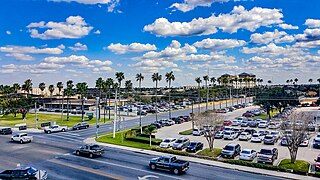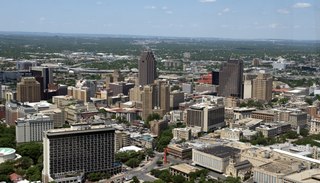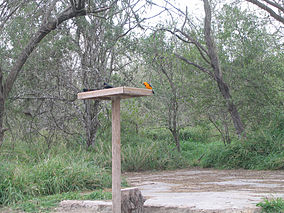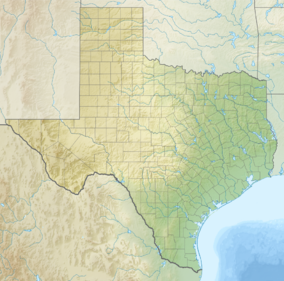
Hidalgo County (; Spanish pronunciation: [iˈð̞alɣ̞o]) is located in the U.S. state of Texas. The county seat is Edinburg and the largest city is McAllen. The county is named for Miguel Hidalgo y Costilla, the priest who raised the call for Mexico's independence from Spain. It is located in the Rio Grande Valley of South Texas and is one of the fastest-growing counties in the United States. As of the 2010 census, the population of Hidalgo County was 774,769, making it the eighth-most populous county in Texas. Hidalgo County is designated by the U.S. Census Bureau as the McAllen-Edinburg-Mission metropolitan statistical area, which itself is part of the McAllen-Edinburg-Mission-Rio Grande City, Texas combined statistical area with neighboring Starr County.

Edinburg is a city in and the county seat of Hidalgo County, Texas, United States. The population was 74,569 as of the 2010 census, and in 2019 the estimated population was 101,170, making it the second largest city in Hidalgo County, and the third largest city in the larger Rio Grande Valley region.

McAllen is the largest city in Hidalgo County, Texas, United States, and the 21st-most populous city in Texas. It is located at the southern tip of the state in the Rio Grande Valley, close to the country of Mexico. The city limits extend south to the Rio Grande, across from the Mexican city of Reynosa. McAllen is about 70 mi (110 km) west of the Gulf of Mexico. As of 2019, McAllen's population was estimated to be 143,268. It is the fifth-most populous metropolitan area (McAllen–Edinburg–Mission) in the state of Texas, and the binational Reynosa–McAllen metropolitan area counts a population of nearly 1.52 million.

Weslaco is a city in Hidalgo County, Texas, United States. As of the 2010 census the population was 35,670, and in 2019 the estimated population was 41,629. It is located at the southern tip of Texas in the Rio Grande Valley near the Mexican border, across the Rio Grande from the city of Nuevo Progreso, Rio Bravo, Tamaulipas.

Lloyd Millard Bentsen Jr. was an American politician who was a four-term United States Senator (1971–1993) from Texas and the Democratic Party nominee for vice president in 1988 on the Michael Dukakis ticket. He also served as the 69th United States Secretary of the Treasury under President Bill Clinton.

The Lower Rio Grande Valley, commonly known as the Rio Grande Valley or locally as The Valley, is a socio-cultural region spanning the border of Texas and Mexico located in a floodplain of the Rio Grande near its mouth. The region includes the southernmost tip of South Texas and a portion of northern Tamaulipas, Mexico. It consists of the Brownsville, Harlingen, Weslaco, Pharr, McAllen, Edinburg, Mission, San Juan, and Rio Grande City metropolitan areas in the United States and the Matamoros, Río Bravo, and Reynosa metropolitan areas in Mexico. These cities are surrounded by many small neighborhoods or colonias. The area is generally bilingual in English and Spanish, with a fair amount of Spanglish due to the diverse history of the region. A large seasonal influx occurs of "winter Texans" — Texans who come down from the north for the winter and then go back up north before summer arrives.

The University of Texas–Pan American (UTPA) was a public university in Edinburg, Texas. Founded in 1927, it was a component institution of the University of Texas System. The university served the Rio Grande Valley and South Texas with baccalaureate, master's, and doctoral degrees. The Carnegie Foundation classified UTPA as a "doctoral research university". From the institution's founding until it was merged into the University of Texas Rio Grande Valley (UTRGV), it grew from 200 students to over 20,000, making UTPA the 10th-largest university in Texas. The majority of these students were natives of the Rio Grande Valley. UTPA also operated an Upper Level Studies Center in Rio Grande City, Starr County, Texas. On August 15, 2014, Dr. Havidan Rodriguez was appointed interim President of UTPA, the institution's final leader.

South Texas is a region of the U.S. state of Texas that lies roughly south of—and includes—San Antonio. The southern and western boundary is the Rio Grande, and to the east it is the Gulf of Mexico. The population of this region is about 4.96 million according to the 2017 census estimates. The southern portion of this region is often referred to as the Rio Grande Valley. The eastern portion along the Gulf of Mexico is also referred to as the Coastal Bend.

The Payne Arena is a multi-purpose complex, in Hidalgo, Texas. It was formerly known as Dodge Arena from 2003 until February 2010, State Farm Arena from 2010 to September 2018, and then State Farm Hidalgo Arena for one year.

The Lower Rio Grande Valley Development Council (LRGVDC) is a voluntary association of cities, counties and special districts in the Rio Grande Valley region of southern Texas.

Valley Nature Center is a 6-acre park and nature preserve in Gibson City Park, Weslaco, Texas. Its focus is environmental education about the natural history of the Lower Rio Grande Valley.

Santa Ana National Wildlife Refuge is a 2,088-acre (8.45 km2) National Wildlife Refuge situated along the banks of the Rio Grande, south of Alamo in the Lower Rio Grande Valley, in Hidalgo County, South Texas.
Lionel Aron Peña, Jr., known as Aaron is an American attorney and politician who for 10 years represented House District 40 in the Texas House of Representatives, a seat he was first sworn into on January 14, 2003. On November 25, 2011, Rep. Aaron Peña announced that he would not seek re-election to a sixth term in office. He ended his tenure with the Texas House of Representatives on January 8, 2013 and returned to his work as an attorney and advisor in the private and public sectors. Currently Peña is employed with the Texas General Land Office, serving under the leadership of Land Commissioner George P. Bush.
The World Birding Center is the official title given to a combined nine parks and nature preserves in the Rio Grande Valley region of Texas managed by a partnership of the Texas Parks and Wildlife Department, the United States Fish and Wildlife Service, and the local communities in which the parks reside. The stated mission of the World Birding Center is to "protect native habitat while increasing the understanding and appreciation of the birds and wildlife", with an additional emphasis on promoting local economic development through ecotourism.

The Tamaulipan mezquital is a deserts and xeric shrublands ecoregion in the southern United States and northeastern Mexico. It covers an area of 141,500 km2 (54,600 sq mi), encompassing a portion of the Gulf Coastal Plain in southern Texas, northern Tamaulipas, northeastern Coahuila, and part of Nuevo León.

The Great Texas Coastal Birding Trail is a state-designated system of trails, bird sanctuaries, and nature preserves along the entire length of the Texas Gulf Coast in the United States. As the state of Texas hosts more bird species than any other state in the U.S. the trail system offers some of the most unusual opportunities for bird-watching in the world. The "trail" is actually 43 separate hiking and driving trails that include 308 birding sites. The sites themselves feature a variety of viewing opportunities with boardwalks, observation decks, and other amenities. The trails boast more than 450 bird species. The trail system is managed by the Texas Parks and Wildlife Department as part of the Great Texas Wildlife Trails which also include the Heart of Texas Wildlife Trail, the Panhandle Plains Wildlife Trail, and the Prairies and Pineywoods Wildlife Trail.

Seminole Canyon State Park and Historic Site is a state park in the U.S. state of Texas. It is located off U.S. Route 90, east of the Pecos River High Bridge, 9 miles (14 km) west of Comstock in Val Verde County. The park is conducive to camping, biking, bird watching, back packing and archeological study. Cave art and archeological artifacts date back to the earliest human habitation in the area. The park is part of the larger Seminole Canyon Archeological District on the National Register of Historic Places.
Resaca de la Palma State Park is one of three state parks belonging to the World Birding Center and managed by the Texas Parks and Wildlife Department. At 1,200 acres, Resaca de la Palma State Park is the largest of the World Birding Center sites and is located in Brownsville. The property was acquired by the Texas Parks and Wildlife Department in 1977 and was opened to the public in December 2008. A resaca is a type of oxbow lake that can be found in Texas, and is a former channels of the Rio Grande. It is naturally cut off from the river, having no inlet or outlet.

The National Butterfly Center is a private nature preserve which serves as an outdoor butterfly conservatory. It is located adjacent to Bentsen-Rio Grande Valley State Park, near the city of Mission in Hidalgo County in the U.S. state of Texas.

La Lomita Chapel is a historic Catholic chapel in Mission, Texas. It was once an important site for the Cavalry of Christ, a group of priests who traveled long distances on horseback to minister to Catholics living on isolated ranches along the Rio Grande.

















